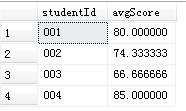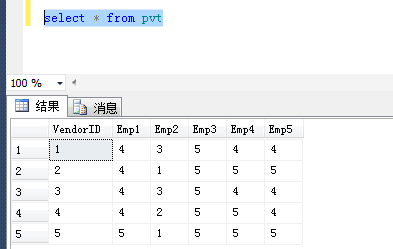SqlServer的PIVOT、UNPIVOT将行转成列,列传成行
pivot
可以把列值转换为输出中的多个列。
pivot 可以在其他剩余的列的值上执行聚合函数。
unpivot
将列转换为列值
语法
SELECT <non-pivoted column>,
[first pivoted column] AS <column name>,
[second pivoted column] AS <column name>,
...
[last pivoted column] AS <column name>
FROM
(<SELECT query that produces the data>)
AS <alias for the source query>
PIVOT
(
<aggregation function>(<column being aggregated>)
FOR
[<column that contains the values that will become column headers>]
IN ( [first pivoted column], [second pivoted column],
... [last pivoted column])
) AS <alias for the pivot table>
<optional ORDER BY clause>;
示例1:pivot
1.数据准备
create table student_score
(
studentId varchar(50),
subjectName varchar(50),
score decimal(18)
)
insert into student_score values
('001','语文',80),('001','数学',70),('001','英语',90),
('002','语文',80),('002','数学',83),('002','英语',60),
('003','语文',50),('003','数学',90),('003','英语',60),
('004','语文',90),('004','数学',80)
按学生id分组查看平均成绩
select studentId,AVG(score) avgScore from student_score group by studentId
初始效果

2.使用pivot
select 'averagescore' as avgScore_by_studentId,
[001],[002],[003],[004]
from
(
select studentId,score
from student_score
) as sourceTable
pivot
(
AVG(score) for studentId in ([001],[002],[003],[004])
) as pivotTable
3.效果

示例2:unpivot
1.数据准备
-- Create the table and insert values as portrayed in the previous example.
CREATE TABLE pvt (VendorID int, Emp1 int, Emp2 int,
Emp3 int, Emp4 int, Emp5 int);
GO
INSERT INTO pvt VALUES (1,4,3,5,4,4);
INSERT INTO pvt VALUES (2,4,1,5,5,5);
INSERT INTO pvt VALUES (3,4,3,5,4,4);
INSERT INTO pvt VALUES (4,4,2,5,5,4);
INSERT INTO pvt VALUES (5,5,1,5,5,5);
GO
初始效果

表示供应商(vendorID)在用户1(Emp1)中的订单数量,其他类比即可。
2.使用示例
-- Unpivot the table.
SELECT VendorID, Employee, Orders
FROM
(SELECT VendorID, Emp1, Emp2, Emp3, Emp4, Emp5
FROM pvt) p
UNPIVOT
(Orders FOR Employee IN
(Emp1, Emp2, Emp3, Emp4, Emp5)
)AS unpvt;
3.效果

分类:
SqlServer







【推荐】国内首个AI IDE,深度理解中文开发场景,立即下载体验Trae
【推荐】编程新体验,更懂你的AI,立即体验豆包MarsCode编程助手
【推荐】抖音旗下AI助手豆包,你的智能百科全书,全免费不限次数
【推荐】轻量又高性能的 SSH 工具 IShell:AI 加持,快人一步
· 被坑几百块钱后,我竟然真的恢复了删除的微信聊天记录!
· 没有Manus邀请码?试试免邀请码的MGX或者开源的OpenManus吧
· 【自荐】一款简洁、开源的在线白板工具 Drawnix
· 园子的第一款AI主题卫衣上架——"HELLO! HOW CAN I ASSIST YOU TODAY
· Docker 太简单,K8s 太复杂?w7panel 让容器管理更轻松!